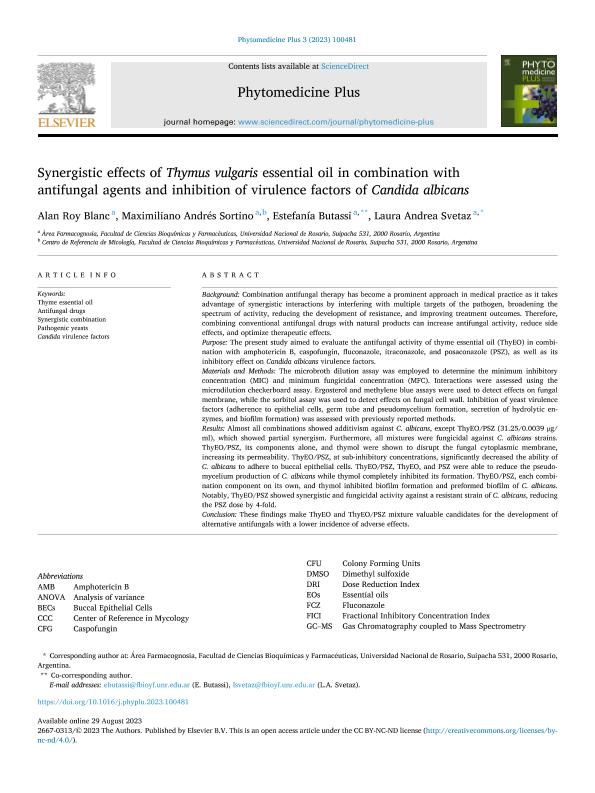Mostrar el registro sencillo del ítem
dc.contributor.author
Blanc, Alan Roy

dc.contributor.author
Sortino, Maximiliano Andrés

dc.contributor.author
Butassi, Estefanía

dc.contributor.author
Svetaz, Laura Andrea

dc.date.available
2024-01-23T13:38:14Z
dc.date.issued
2023-11
dc.identifier.citation
Blanc, Alan Roy; Sortino, Maximiliano Andrés; Butassi, Estefanía; Svetaz, Laura Andrea; Synergistic effects of Thymus vulgaris essential oil in combination with antifungal agents and inhibition of virulence factors of Candida albicans; Elsevier; Phytomedicine Plus; 3; 4; 11-2023; 1-11
dc.identifier.issn
2667-0313
dc.identifier.uri
http://hdl.handle.net/11336/224589
dc.description.abstract
Background: Combination antifungal therapy has become a prominent approach in medical practice as it takes advantage of synergistic interactions by interfering with multiple targets of the pathogen, broadening the spectrum of activity, reducing the development of resistance, and improving treatment outcomes. Therefore, combining conventional antifungal drugs with natural products can increase antifungal activity, reduce side effects, and optimize therapeutic effects. Purpose: The present study aimed to evaluate the antifungal activity of thyme essential oil (ThyEO) in combination with amphotericin B, caspofungin, fluconazole, itraconazole, and posaconazole (PSZ), as well as its inhibitory effect on Candida albicans virulence factors. Materials and Methods: The microbroth dilution assay was employed to determine the minimum inhibitory concentration (MIC) and minimum fungicidal concentration (MFC). Interactions were assessed using the microdilution checkerboard assay. Ergosterol and methylene blue assays were used to detect effects on fungal membrane, while the sorbitol assay was used to detect effects on fungal cell wall. Inhibition of yeast virulence factors (adherence to epithelial cells, germ tube and pseudomycelium formation, secretion of hydrolytic enzymes, and biofilm formation) was assessed with previously reported methods. Results: Almost all combinations showed additivism against C. albicans, except ThyEO/PSZ (31.25/0.0039 µg/ml), which showed partial synergism. Furthermore, all mixtures were fungicidal against C. albicans strains. ThyEO/PSZ, its components alone, and thymol were shown to disrupt the fungal cytoplasmic membrane, increasing its permeability. ThyEO/PSZ, at sub-inhibitory concentrations, significantly decreased the ability of C. albicans to adhere to buccal epithelial cells. ThyEO/PSZ, ThyEO, and PSZ were able to reduce the pseudomycelium production of C. albicans while thymol completely inhibited its formation. ThyEO/PSZ, each combination component on its own, and thymol inhibited biofilm formation and preformed biofilm of C. albicans. Notably, ThyEO/PSZ showed synergistic and fungicidal activity against a resistant strain of C. albicans, reducing the PSZ dose by 4-fold. Conclusion: These findings make ThyEO and ThyEO/PSZ mixture valuable candidates for the development of alternative antifungals with a lower incidence of adverse effects.
dc.format
application/pdf
dc.language.iso
eng
dc.publisher
Elsevier

dc.rights
info:eu-repo/semantics/openAccess
dc.rights.uri
https://creativecommons.org/licenses/by-nc-nd/2.5/ar/
dc.subject
ANTIFUNGAL DRUGS
dc.subject
CANDIDA VIRULENCE FACTORS
dc.subject
PATHOGENIC YEASTS
dc.subject
SYNERGISTIC COMBINATION
dc.subject
THYME ESSENTIAL OIL
dc.subject.classification
Química Orgánica

dc.subject.classification
Ciencias Químicas

dc.subject.classification
CIENCIAS NATURALES Y EXACTAS

dc.title
Synergistic effects of Thymus vulgaris essential oil in combination with antifungal agents and inhibition of virulence factors of Candida albicans
dc.type
info:eu-repo/semantics/article
dc.type
info:ar-repo/semantics/artículo
dc.type
info:eu-repo/semantics/publishedVersion
dc.date.updated
2024-01-22T12:50:02Z
dc.journal.volume
3
dc.journal.number
4
dc.journal.pagination
1-11
dc.journal.pais
Países Bajos

dc.journal.ciudad
Amsterdam
dc.description.fil
Fil: Blanc, Alan Roy. Universidad Nacional de Rosario. Facultad de Ciencias Bioquímicas y Farmacéuticas. Departamento de Química Orgánica. Área Farmacognosia; Argentina. Consejo Nacional de Investigaciones Científicas y Técnicas. Centro Científico Tecnológico Conicet - Rosario; Argentina
dc.description.fil
Fil: Sortino, Maximiliano Andrés. Universidad Nacional de Rosario. Facultad de Ciencias Bioquímicas y Farmacéuticas. Departamento de Química Orgánica. Área Farmacognosia; Argentina. Consejo Nacional de Investigaciones Científicas y Técnicas. Centro Científico Tecnológico Conicet - Rosario; Argentina
dc.description.fil
Fil: Butassi, Estefanía. Consejo Nacional de Investigaciones Científicas y Técnicas. Centro Científico Tecnológico Conicet - Rosario; Argentina. Universidad Nacional de Rosario. Facultad de Ciencias Bioquímicas y Farmacéuticas. Departamento de Química Orgánica. Área Farmacognosia; Argentina
dc.description.fil
Fil: Svetaz, Laura Andrea. Consejo Nacional de Investigaciones Científicas y Técnicas. Centro Científico Tecnológico Conicet - Rosario; Argentina. Universidad Nacional de Rosario. Facultad de Ciencias Bioquímicas y Farmacéuticas. Departamento de Química Orgánica. Área Farmacognosia; Argentina
dc.journal.title
Phytomedicine Plus
dc.relation.alternativeid
info:eu-repo/semantics/altIdentifier/url/https://linkinghub.elsevier.com/retrieve/pii/S2667031323000775
dc.relation.alternativeid
info:eu-repo/semantics/altIdentifier/doi/http://dx.doi.org/10.1016/j.phyplu.2023.100481
Archivos asociados
